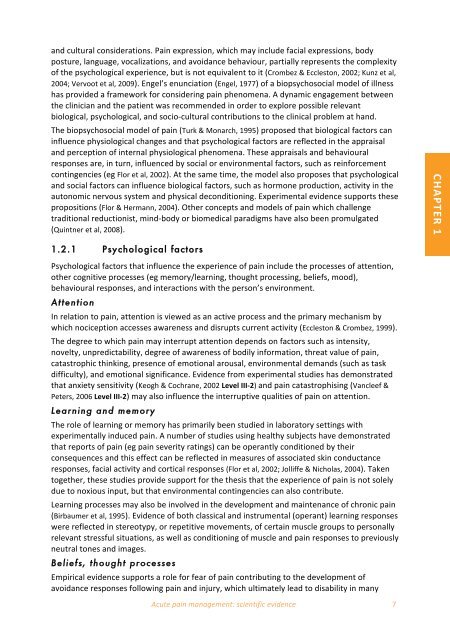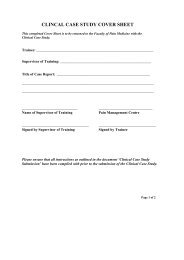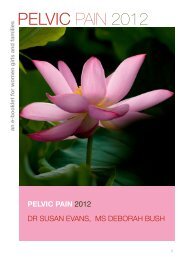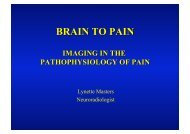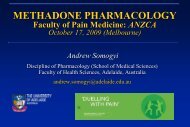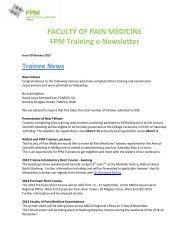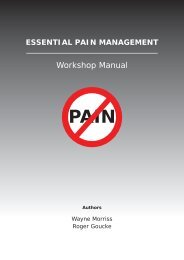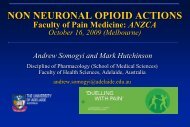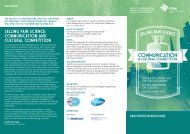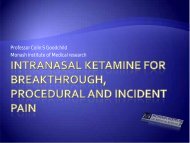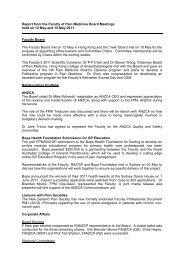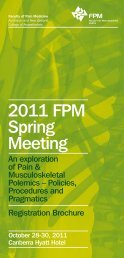Acute Pain - final version - Faculty of pain medicine - Australian and ...
Acute Pain - final version - Faculty of pain medicine - Australian and ...
Acute Pain - final version - Faculty of pain medicine - Australian and ...
Create successful ePaper yourself
Turn your PDF publications into a flip-book with our unique Google optimized e-Paper software.
<br />
<br />
<strong>and</strong> cultural considerations. <strong>Pain</strong> expression, which may include facial expressions, body <br />
posture, language, vocalizations, <strong>and</strong> avoidance behaviour, partially represents the complexity <br />
<strong>of</strong> the psychological experience, but is not equivalent to it (Crombez & Eccleston, 2002; Kunz et al, <br />
2004; Vervoot et al, 2009). Engel’s enunciation (Engel, 1977) <strong>of</strong> a biopsychosocial model <strong>of</strong> illness <br />
has provided a framework for considering <strong>pain</strong> phenomena. A dynamic engagement between <br />
the clinician <strong>and</strong> the patient was recommended in order to explore possible relevant <br />
biological, psychological, <strong>and</strong> socio‐cultural contributions to the clinical problem at h<strong>and</strong>. <br />
The biopsychosocial model <strong>of</strong> <strong>pain</strong> (Turk & Monarch, 1995) proposed that biological factors can <br />
influence physiological changes <strong>and</strong> that psychological factors are reflected in the appraisal <br />
<strong>and</strong> perception <strong>of</strong> internal physiological phenomena. These appraisals <strong>and</strong> behavioural <br />
responses are, in turn, influenced by social or environmental factors, such as reinforcement <br />
contingencies (eg Flor et al, 2002). At the same time, the model also proposes that psychological <br />
<strong>and</strong> social factors can influence biological factors, such as hormone production, activity in the <br />
autonomic nervous system <strong>and</strong> physical deconditioning. Experimental evidence supports these <br />
propositions (Flor & Hermann, 2004). Other concepts <strong>and</strong> models <strong>of</strong> <strong>pain</strong> which challenge <br />
traditional reductionist, mind‐body or biomedical paradigms have also been promulgated <br />
(Quintner et al, 2008). <br />
CHAPTER 1 <br />
1.2.1 Psychological factors<br />
Psychological factors that influence the experience <strong>of</strong> <strong>pain</strong> include the processes <strong>of</strong> attention, <br />
other cognitive processes (eg memory/learning, thought processing, beliefs, mood), <br />
behavioural responses, <strong>and</strong> interactions with the person’s environment. <br />
Attention<br />
In relation to <strong>pain</strong>, attention is viewed as an active process <strong>and</strong> the primary mechanism by <br />
which nociception accesses awareness <strong>and</strong> disrupts current activity (Eccleston & Crombez, 1999). <br />
The degree to which <strong>pain</strong> may interrupt attention depends on factors such as intensity, <br />
novelty, unpredictability, degree <strong>of</strong> awareness <strong>of</strong> bodily information, threat value <strong>of</strong> <strong>pain</strong>, <br />
catastrophic thinking, presence <strong>of</strong> emotional arousal, environmental dem<strong>and</strong>s (such as task <br />
difficulty), <strong>and</strong> emotional significance. Evidence from experimental studies has demonstrated <br />
that anxiety sensitivity (Keogh & Cochrane, 2002 Level III‐2) <strong>and</strong> <strong>pain</strong> catastrophising (Vancleef & <br />
Peters, 2006 Level III‐2) may also influence the interruptive qualities <strong>of</strong> <strong>pain</strong> on attention. <br />
Learning <strong>and</strong> memory<br />
The role <strong>of</strong> learning or memory has primarily been studied in laboratory settings with <br />
experimentally induced <strong>pain</strong>. A number <strong>of</strong> studies using healthy subjects have demonstrated <br />
that reports <strong>of</strong> <strong>pain</strong> (eg <strong>pain</strong> severity ratings) can be operantly conditioned by their <br />
consequences <strong>and</strong> this effect can be reflected in measures <strong>of</strong> associated skin conductance <br />
responses, facial activity <strong>and</strong> cortical responses (Flor et al, 2002; Jolliffe & Nicholas, 2004). Taken <br />
together, these studies provide support for the thesis that the experience <strong>of</strong> <strong>pain</strong> is not solely <br />
due to noxious input, but that environmental contingencies can also contribute. <br />
Learning processes may also be involved in the development <strong>and</strong> maintenance <strong>of</strong> chronic <strong>pain</strong> <br />
(Birbaumer et al, 1995). Evidence <strong>of</strong> both classical <strong>and</strong> instrumental (operant) learning responses <br />
were reflected in stereotypy, or repetitive movements, <strong>of</strong> certain muscle groups to personally <br />
relevant stressful situations, as well as conditioning <strong>of</strong> muscle <strong>and</strong> <strong>pain</strong> responses to previously <br />
neutral tones <strong>and</strong> images. <br />
Beliefs, thought processes<br />
Empirical evidence supports a role for fear <strong>of</strong> <strong>pain</strong> contributing to the development <strong>of</strong> <br />
avoidance responses following <strong>pain</strong> <strong>and</strong> injury, which ultimately lead to disability in many <br />
<strong>Acute</strong> <strong>pain</strong> management: scientific evidence 7


